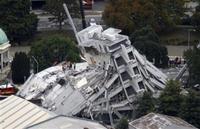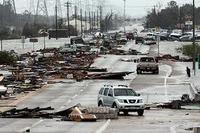-
How disaster survivors survive Thanksgiving
This year’s rash of deadly natural disasters has displaced tens of thousands of people and shattered families across the United States; with the Thanksgiving holiday approaching, many will find it impossible to celebrate in their own home or be forced to face an empty seat once occupied by a loved one
-
-
USDA declares NY and PA counties disaster zones
The U.S. Department of Agriculture (USDA) recently announced that several counties Pennsylvania and New York are now eligible for federal disaster aid
-
-
Building design lessons from the Christchurch earthquake

A leading infrastructure expert believes an assessment needs to be made of the level of “very rare” earthquake that needs to be considered in structural design, perhaps one with a 10,000 year return period or higher, rather than the 500 year return period that is commonly adopted for many buildings in Australia
-
-
Plan to protect Houston from the next big hurricane

To protect Houston and Galveston from future hurricanes, experts recommends building a floodgate across the Houston Ship Channel, adding new levees to protect densely populated areas on Galveston Island and the developed west side of Galveston Bay; the team also recommends creating a 130-mile-long coastal recreation area to sustainably use wetlands that act as a natural flood barrier
-
-
States over reliant on FEMA aid for small disasters
This year’s unprecedented number of major natural disasters including Hurricane Irene, the record number of tornadoes, and the floods along the entire Mississippi and Missouri rivers strained the Federal Emergency Management’s (FEMA) coffers, but the number of relatively minor disasters that were declared as “major disasters” pushed FEMA resources beyond their limit; some critics say this trend needs to stop
-
-
Costly October disasters worldwide
October saw devastating — and costly — natural disasters in different parts of the world; in Thailand, the flooding has impacted 64 of Thailand’s 77 provinces, affecting more than 9.9 million people with at least 427 reported dead. Preliminary economic losses have been listed at $9.8 billion, with insured losses already estimated at more than $4.6 billion
-
-
Eight months later, Fukushima reactor could still be active
Troubles continue at the beleaguered Fukushima Daichii nuclear power plant in Japan with officials detecting radioactive xenon gas, a byproduct of nuclear fission, from reactor two nearly eight months after the dangerous meltdowns
-
-
Meth lab found in FEMA temporary housing in Joplin

Following the devastating tornado that leveled Joplin, Missouri in May, thousands of residents were forced to take up temporary housing in FEMA mobile home parks, but of late many have become increasingly uneasy about their living situation following the discovery of a methamphetamine lab in a FEMA temporary housing complex
-
-
Air pollution in Arabian Sea linked to cyclone intensity
Pollution is making Arabian Sea cyclones more intense, according to a just-published study; traditionally, prevailing wind shear patterns prohibit cyclones in the Arabian Sea from becoming major storms; the new study suggests that weakening winds have enabled the formation of stronger cyclones in recent years
-
-
Army engineers need $1 billion to repair damaged levees
The U.S. Army Corps of Engineers is urgently requesting $1 billion to repair flood control systems along the Mississippi and Missouri river basins following damage from record floods this spring; the historic flooding forced the corps to blow up portions of the levee to relieve pressure, flooding thousands of acres of farmland to protect cities along the rivers
-
-
FEMA chief: agency to recover $1 billion for disaster relief fund
Testifying before the House Homeland Security Subcommittee last week, Federal Emergency Management Agency (FEMA) administrator Craig Fugate said the agency expects to recover about $1 billion from its disaster relief projects this fiscal year
-
-
Bangkok's losing battle against floods
The Thailand government has been taking desperate measure to try and prevent a massive flow of water from inundating the Thai capital — parts of which are already under water. The swelling Chao Phraya river, which meanders through the heart of the sprawling city, has already flooded several neighborhoods, while swelling water from the Gulf of Thailand poses another threat. One reason for Bangkok’s growing flood problem is the fact that over the last two decades, many draining canals have been paved over to make room for roads, leaving rising water with no way to escape.
-
-
Israel's aid to Turkey "humanitarian, not political"
Israel was among the first countries to rush plane-loads of disaster and search and rescue equipment to Turkey after last Sunday’s devastated earthquake which has killed more than 550 and displaced thousands. Both sides insist that the disaster relief was a humanitarian gesture which will have no effect on the deteriorating relations between these two former allies.
-
-
Four tremors hit Bay Area
Thursday saw the fourth tremor in as many days to hit California’s Bay Area. The 3.6 quake hit the Berkeley area at 5:30am. Unsettling as the quakes were, geologists have even more disturbing news for Bay Area residents: they say the quakes were much too small to relieve the seismic pressures that have been building along the Hayward Fault since the last Big One hit the area in 1868. Studies show that the Big Ones hit the area at regular intervals of about 160 years — meaning another Big One is coming.
-
-
Also noted
Fukushima nuke pollution in sea ‘was world’s worst’ | Study: Japan nuclear radiation higher than estimated |FDA readies food transportation safety regulation | Report: China suspect in satellite interference by U.S.| Nuclear Power Safety Experts to Convene in Washington, D.C.| Texas Adds New Cameras To Border Security | Ottawa is hosting a major conference on non-lethal weapons technology
-
- All
- Regional
- Water
- Biometrics
- Borders/Immig
- Business
- Cybersecurity
- Detection
- Disasters
- Government
- Infrastructure
- International
- Public health
- Public Safety
- Communication interoperabillity
- Emergency services
- Emergency medical services
- Fire
- First response
- IEDs
- Law Enforcement
- Law Enforcement Technology
- Military technology
- Nonlethal weapons
- Nuclear weapons
- Personal protection equipment
- Police
- Notification /alert systems
- Situational awareness
- Weapons systems
- Sci-Tech
- Sector Reports
- Surveillance
- Transportation
Advertising & Marketing: advertise@newswirepubs.com
Editorial: editor@newswirepubs.com
General: info@newswirepubs.com
2010-2011 © News Wire Publications, LLC News Wire Publications, LLC
220 Old Country Road | Suite 200 | Mineola | New York | 11501
Permissions and Policies
Editorial: editor@newswirepubs.com
General: info@newswirepubs.com
2010-2011 © News Wire Publications, LLC News Wire Publications, LLC
220 Old Country Road | Suite 200 | Mineola | New York | 11501
Permissions and Policies
